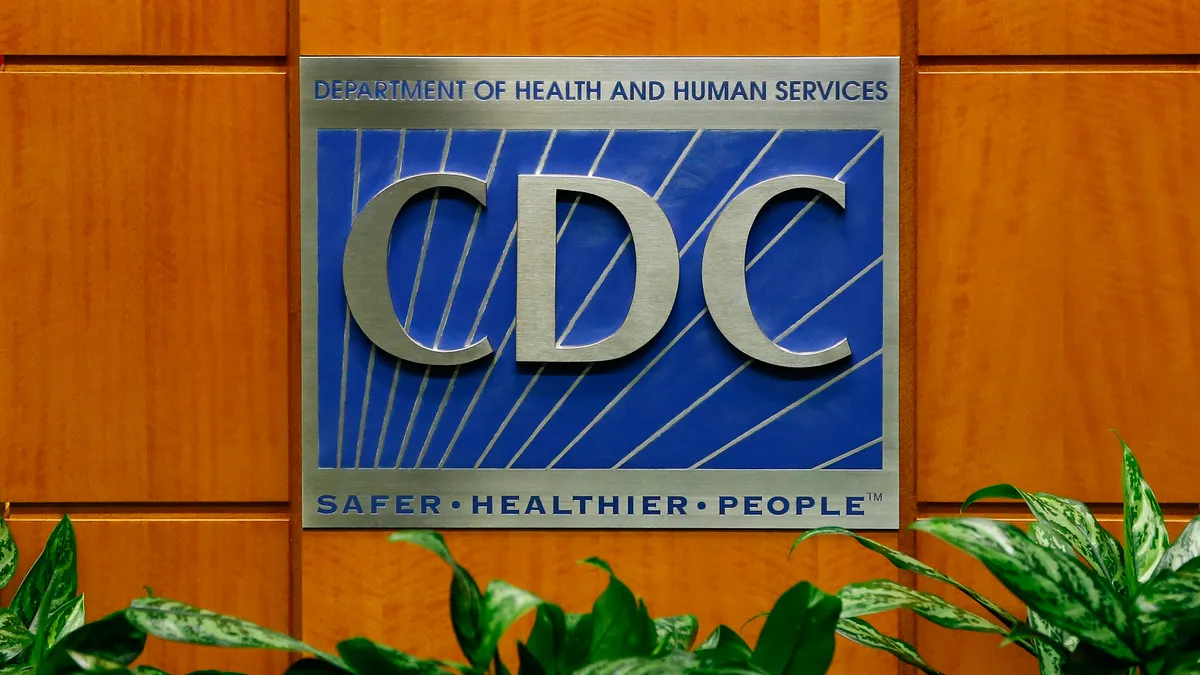In 2015, Bill Gates caused a media stir by expressing optimism that a vaccine and a cure for HIV will become a reality within the next 15 years. The National Institutes of Health and other researchers have made progress in understanding how HIV antibodies develop and the potential of a vaccine to stimulate the immune system of those without HIV infection to produce these antibodies, however the science is still considered to be in its infancy.
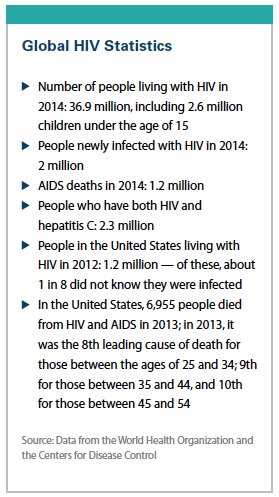 The challenges of developing a preventive vaccine for HIV are many — including a virus that has several subtypes, a virus that mutates, as well as funding issues — but researchers are optimistic that a vaccine is possible. In the last two decades, tremendous progress has been made against HIV/AIDS, transforming the disease from a fatal illness to a chronic condition for many, especially in developed nations. The mortality rate associated with HIV has declined in developed nations, thanks to both behavioral changes and the use of anti-retroviral drugs.
The challenges of developing a preventive vaccine for HIV are many — including a virus that has several subtypes, a virus that mutates, as well as funding issues — but researchers are optimistic that a vaccine is possible. In the last two decades, tremendous progress has been made against HIV/AIDS, transforming the disease from a fatal illness to a chronic condition for many, especially in developed nations. The mortality rate associated with HIV has declined in developed nations, thanks to both behavioral changes and the use of anti-retroviral drugs.
But in developing nations, HIV and AIDS are not under control. More than 95% of HIV infections are in developing countries and two-thirds of these nations are in sub-Saharan Africa, where more than 28 million people are living with HIV. The vast majority of people in developing countries who are living with HIV/AIDS are unable to access life-saving treatments for HIV infection and related opportunistic infections, according to the Interagency Coalition on AIDS and Development.
Donations and price reductions offered by pharmaceutical companies are helping in the fight against HIV but the coalition says this is not a sustainable solution. Many countries also lack clean water and have inadequate health infrastructures for providing treatment.
Even in the United States there is still cause for concern, says J. Joseph Kim, Ph.D., president and CEO of Inovio Pharmaceuticals.
“The fastest growing infection rate cohort is people under the age of 25, and the second fastest is those over the age of 65 in this country," he says. “There is complacency because of the availability of therapeutic regimens that can control the virus. Those drugs have been miraculously effective in the recent years. But they are not without side effects. We all know in the field that the only way to control an infection in a permanent way is through proper development and use of vaccines. This is what history has shown us, whether it’s smallpox, polio, measles, or other childhood diseases."
Researchers remain hopeful that a successful HIV vaccine is a real possibility in the foreseeable future. Although the exact timing is hard to predict, recent advances seem to make this goal more plausible.
In fact, there’s a renewed effort to produce an HIV vaccine that can properly control new infections, as well as act as an immunotherapy when used in combination with currently available highly powerful drugs, which can bring about a cure similar to what is happening in the hepatitis C space, Dr. Kim says.
Learning From the Past for a New Future
HIV vaccine research in the past has been fraught with failure.
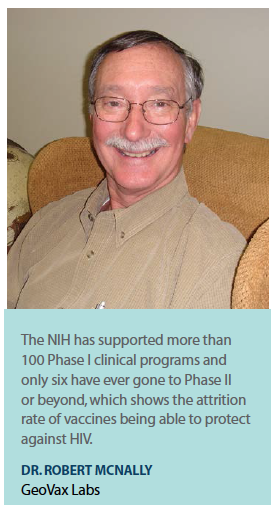 “The NIH has supported more than 100 Phase I clinical programs and only six have ever gone to Phase II or beyond, which shows the attrition rate of vaccines being able to protect against HIV," says Robert McNally, Ph.D., president and CEO of GeoVax Labs.
“The NIH has supported more than 100 Phase I clinical programs and only six have ever gone to Phase II or beyond, which shows the attrition rate of vaccines being able to protect against HIV," says Robert McNally, Ph.D., president and CEO of GeoVax Labs.
HIV vaccine research slowed after the failure of the STEP trial in 2007. This international HIV vaccine clinical trial — also referred to as the HVTN 502 or Merck V520-023 study — began enrolling volunteers in December 2004. It was co-sponsored by the National Institute of Allergy and Infectious Diseases (NIAID), part of the NIH, and Merck, which also developed and supplied the candidate vaccine.
Trials were stopped when they failed to show efficacy. Further analysis of the data in 2011 revealed that certain subgroups of male study participants were at higher risk of becoming infected after receiving the experimental vaccine compared with those who received a placebo.
HIV is very different from most other vaccine-preventable viral diseases. It attacks the immune system, and it is diverse and can easily mutate to avoid the immune response. This makes it difficult to make a vaccine that would protect against the different subtypes of the disease. Additionally, most viruses elicit neutralizing antibodies to protect against disease, but this occurs in only a minority of HIV cases and only after several years of infection.
“We didn’t appreciate how different HIV is from other viruses for a very long time," says Joe Jardine, Ph.D., research associate at The Scripps Research Institute (TSRI). “Early HIV research was done using strains of the virus that were grown in the lab in a way that allows them to be easily neutralized by antibodies. Traditional strategies for vaccine development successfully produced an antibody response that could neutralize the early lab-adapted viruses, but were unable to neutralize viruses in the circulating population, thus did not provide protection. We spent a long time trying things the traditional way because we didn’t know what else to do."
Another challenge has been identifying HIV-specific neutralizing antibodies.
“Despite more than 30 years of research, it is still unclear exactly what type of antibody or immune response is needed to be protective," says Susie Sargent, M.D., medical director, infectious diseases — medical affairs, at PRA Health Sciences.
It’s now known that HIV is characterized by latching onto the CD4 protein on the cell surface of the T-cells. It then infects those T-cells, which are responsible for the immunity of the whole system. Unlike other viruses, HIV is able to adapt to mask itself from an immune response.
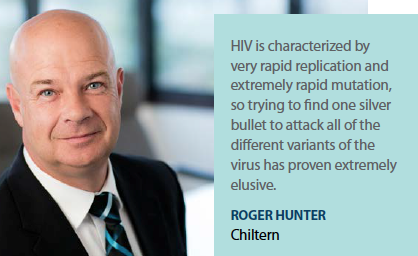 “HIV is incredibly resistant to the antibodies that the human immune system can create," Dr. Jardine says. “The approach to make a protective vaccine must find a way to overcome the strategies HIV has evolved to hide from neutralizing antibodies."
“HIV is incredibly resistant to the antibodies that the human immune system can create," Dr. Jardine says. “The approach to make a protective vaccine must find a way to overcome the strategies HIV has evolved to hide from neutralizing antibodies."
The development of an effective HIV vaccine has faced two major challenges: finance and science, says Roger Hunter, executive VP, scientific affairs and strategic development, Chiltern.
“The financial issues have been largely overcome by creative government, nongovernment, and industry partnerships" he says. “From a scientific perspective, while there has been significant progress, challenges remain. HIV is characterized by very rapid replication and extremely rapid mutation, so trying to find one silver bullet to attack all of the different variants of the virus has proven elusive."
Mr. Hunter believes that the ultimate scientific solution may require creative combination approaches of many of the vaccine initiatives under way in a similar way to the resolution of the financial issue.
“The solution may also look different if we are considering a therapeutic vaccine in patients with established infection or a preventive vaccine for individuals who have not yet been exposed to the virus," he says.
The Thai Trial
Despite the challenges, researchers are hopeful about the potential of an HIV vaccine. Bringing about this hope was the positive results of the Thai trial, which showed that a HIV vaccine is possible. The Phase III trial of RV144 was conducted by the U.S. Military HIV Research Program (MHRP). It tested the “prime-boost" combination of two vaccines: Sanofi Pasteur’s ALVAC HIV vaccine (the prime) and VaxGen’s AIDSVAX B/E vaccine (the boost). The vaccine combination was based on HIV strains that commonly circulate in Thailand.
The study, which began in 2003, was an international collaborative effort that involved more than 16,000 Thai volunteers and hundreds of scientists and clinicians from Thailand, Europe, and the United States.
The trial demonstrated that the vaccine regimen was safe and modestly effective in preventing HIV infection. The results, announced by the Army in 2009, show that the prime-boost combination lowered the rate of HIV infection by 31.2% compared with placebo based on the modified intent-to-treat population.
The Thai trial has contributed essential knowledge about HIV vaccines and represents an important scientific milestone for global HIV/AIDS research.
“By examining serum from subjects in the RV144 vaccine trial reported in 2009, scientists have identified features of protective antibodies among the vaccine recipients that were previously unknown," Dr. Sargent says. “Researchers are now in the process of using this information to better understand the mechanisms of HIV vaccine protection and to develop new study designs with improved adjuvants to capitalize on that knowledge."
The Bill & Melinda Gates Foundation is participating in this initiative. HIV is one of the leading priorities of the Bill & Melinda Gates Foundation, which focuses its efforts in the poorest countries of Sub-Saharan Africa. To date, the foundation has committed more than $2.5 billion in HIV grants to organizations around the world.
The foundation has also committed more than $1.4 billion to the Global Fund to Fight AIDS, Tuberculosis and Malaria.
Follow-up studies of the Thai trial continue. MHRP began a small clinical study, RV305, in April 2012 in Thailand to evaluate re-boosting in volunteers who participated in the first study. Another clinical study, RV306, began in September 2013 using the RV144 vaccine regimen to compare additional vaccine boosts and gather more immunogenicity data in 360 new volunteers. Additionally, a small Phase I trial to evaluate the RV144 vaccine regimen in 100 volunteers in South Africa began in June 2013. This trial, HVTN 097, aimed to ensure that the vaccine regimen tested in Thailand, targeting subtypes B and E, is safe and well-tolerated in this population.
A public-private collaborative team, called the Pox-Protein Public-Private Partnership (P5), also is conducting follow-up clinical studies using a similar vaccine regimen in Southern Africa and Phase I studies began in early 2015. Researchers are hoping to improve and prolong the level of protection by using an extra vaccine boost and better adjuvants in these studies.
For this effort, the HIV Vaccine Trial Network (HVTN) is conducting clinical trials in heterosexual adults that will evaluate a prime-boost vaccine regimen similar to that used in the RV144 study adjusted to target the most common subtype of HIV in the region (subtype C).
A modified version (subtype C) of ALVAC, the pox vector vaccine used in the RV144 trial, will be used as the prime or first vaccination received by study participants. That prime will be followed by boost vaccinations with the vector and Bivalent GP120, a protein product adjusted for subtype C.
Current Research Efforts
The NIH, biopharmaceutical companies, and other researchers are also continuing research for an effective vaccine for HIV.
The Scripps Research Institute (TSRI), for example, is researching a vaccine strategy that would involve three to five sequential doses. The research is still currently in animal studies, although Dr. Jardine says TSRI and the International AIDS Vaccine Initiative (IAVI), with funding from the Bill & Melinda Gates Foundation, are currently working on developing the first vaccine stage for human trials.
Dr. Jardine’s research focuses on a germline targeted vaccine. The theory behind this work is that the original germline antibody (containing no mutations) is unable to recognize HIV, thus a traditionally formulated vaccine will not stimulate the antibodies that have the potential to mature into antibodies that can neutralize HIV. To overcome this, he engineered a piece of HIV to recognize the unmutated germline antibodies from a healthy person to initiate the immune process. He focused VRC01-class antibodies, because they can neutralize ~90% of the strains of HIV and the germline precursors can be predicted with a high degree of certainty.
Dr. Jardine used a computational protein modeling software suite called Rosetta in conjunction with directed evolution to improve the binding of HIV’s envelope protein to VRC01 germline antibodies. He was able to produce an optimized immunogen, which is called eOD-GT8. Upon immunization with eOD-GT8 in mice that have been engineered to produce VRC01 germline antibodies, researchers observed that eOD-GT8 activated the right antibodies, and the mutations these antibodies developed were similar to VRC01. This suggested that eOD-GT8 60mer could be a good candidate to serve as the first in a series of immunizations against HIV.
“We are using eOD-GT8 in transgenic mice right now, and the results are looking quite promising," he says. “In these animal models, we know we can reliably initiate a VRC01-class antibody response by vaccination, starting the right antibodies mutating. We are currently building on that discovery, experimenting with different boosting immunogens to determine how to elicit antibodies with enough of the right mutations that they can neutralize the virus."
One biopharmaceutical companies that is working in the HIV vaccine area is GeoVax. The company’s vaccines typically contain agents (antigens) that resemble disease-causing microorganisms. Traditional vaccines are often made from weakened or killed forms of the virus or from its surface proteins. The company’s approach uses recombinant DNA or recombinant viruses to produce virus-like particles (VLPs) in the person being vaccinated. VLPs train the body’s immune system to recognize and kill the authentic virus should it appear. VLPs also train the immune system to recognize and kill infected cells to control infection and reduce the length and severity of disease.
“The virus-like particles are non-infectious, and they resemble HIV in both size and width, but in particular, the envelope protein that’s on the surface the portion of the virus that is used to attach to other cells," Dr. McNally says. “These particles train the immune system to build up both antibodies and T-cells to kill the virus. We’ve demonstrated this very effectively in the HIV space."
GeoVax’s HIV program has completed a Phase IIA trial and the company is collaborating with the National Institutes of Health for an efficacy trial.
“The NIH wants us to combine our vaccine with proteins so we’re waiting on these proteins to be tested in order to have another arm of what would be an efficacy Phase IIB trial," Dr. McNally says.
Dr. McNally adds that the company’s goal is to take this product through Phase IIb studies and then license it to a partner for Phase III testing.
The NIH and the HIV Vaccine Trials Network (HVTN) continue to be supportive of GeoVax’s preventive vaccine — GOVX-B11 — for the clade B subtype of HIV prevalent in the North America and Western Europe. Plans continue for HVTN to begin the next clinical trial of GOVX-B11 to test the ability of protein boosts to increase the already impressive antibody responses elicited by the vaccine. The company expects this study to begin in mid-2016. Additionally, with NIH grant support the company’s vaccine for the clade C subtype of HIV prevalent in Africa has now progressed to testing in primates.
GeoVax is also researching this technology in the immune-oncology space for solid tumors.
“Our approach on this has been primarily to focus on antigens that are secreted by the tumors and to put the antigens in our vaccine and again, do the same thing, create the antibodies and T-cells, which would go back to attack the cancer itself," Dr. McNally says. “We would have to incorporate checkpoint inhibitors such as PD-1, which are the new wave of activity. And because of our success with VLPs, we’ve also entered into the Zika vaccine space. There are many other companies that are doing similar research, but our approach is to use our platform using virus-like particles to see if we can be more effective.
“We’ve also demonstrated that we can create virus-like particles in the Ebola space, and we’re working on a tetravalent version of Ebola, which means that we have two of the strains of Ebola — the more popular strains of Ebola plus Marburg — plus Lassa fever, for what we expect will be a very effective vaccine to protect against hemorrhagic fevers," Dr. McNally says.
Another company researching HIV vaccines is Inovio Pharmaceuticals. Inovio has completed preliminary studies focused on the HIV vaccine Pennvax-B targeting clade B to achieve proof of principle in generating immune responses. The company has incorporated the knowledge from this HIV program into the design of a multi-clade Pennvax-GP vaccine, which is now the lead preventive and therapeutic vaccine that broadly targets global HIV strains.
In September 2015, the company began a Phase I clinical trial of Pennvax-GP. The trial will measure immune responses following administration of the vaccine in four groups of healthy subjects receiving the vaccine with and without an immune activator (IL-12) and delivered into muscle or skin using Inovio’s Cellectra delivery technology. This study is being conducted by the HVTN and funded through a $25 million NIAID contract awarded to Inovio and its collaborators.
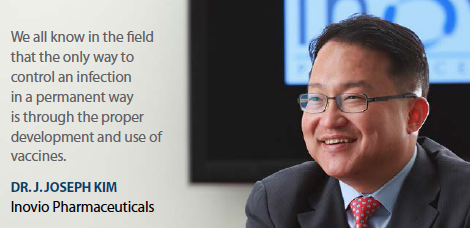 Dr. Kim says the trial is enrolling 94 healthy volunteers in the United States for a prevention study.
Dr. Kim says the trial is enrolling 94 healthy volunteers in the United States for a prevention study.
“The study — HVTN-098 — is measuring the safety and immune responses being generating in CDA T-cell response, as well as antibody responses generated by the vaccine in these volunteers," Dr. Kim says. “We will not be testing the preventive power of this vaccine. But this is a stepping stone to an efficacy trial that will be conducted globally, where we will be vaccinating volunteers versus a placebo. We’ll enroll thousands of people to look at the impact of the vaccine compared with unvaccinated placebo subjects and the rate of infection in that population."
Inovio is also planning a sister study to HVTN-098 in about 20 HIV infected patients, who are on antiretroviral drugs combined with the vaccination in the hopes of clearing the virus in the viral reservoirs, the various organs in the body where the HIV virus hides away when they’re attacked by the drugs, Dr. Kim explains.
“Some of the experts in the field believe that a combination of a powerful vaccine that can generate the proper killer T-cell immune responses against the virus like Pennvax-GP used in concordance with a very powerful combination of HIV drugs, could have a potential impact on clearing the virus that’s hidden away in the reservoirs," Dr. Kim says.
Inovio researchers believe they have a proof of concept for this. The company has published the results of Phase IIb studies in treating women with HPV caused cervical dysplasia and women who actually have an active infection with HPV in their cervix.
“We’ve shown that only three injections into the arm were able to clear the cervical dysplasia lesions and also clear chronically infected HPV virus from the cervix," Dr. Kim says. “To our knowledge this is the first time a therapeutic vaccine or immunotherapy was able to demonstrate the clearance of chronic infection of virus from a distal tissue or distal organ, in this case the cervix. This provides us with a strong proof of principle to go after chronic infections, hard to treat chronic infections such as HIV, as well as a second program for an immunotherapy for clearing chronic hepatitis B virus." (PV)






